-
PESQUISA01/01/2017
Promoting oral care in the preschool child: effects of a playful learning intervention
Revista Brasileira de Enfermagem. 2017;70(3):519-525
Resumen
PESQUISAPromoting oral care in the preschool child: effects of a playful learning intervention
Revista Brasileira de Enfermagem. 2017;70(3):519-525
DOI 10.1590/0034-7167-2016-0237
Visualizações0Ver maisABSTRACT
Objective:
To compare the number of appropriate behaviors for tooth brushing before and after a playful learning intervention with preschool children.
Method:
A quasi-experimental, quantitative, before and after study design was conducted in an early childhood educational institution, with children between three and five years of age. The intervention consisted of three meetings with educational activities about tooth brushing, whose outcome was evaluated by means of observation of ten behaviors suitable for tooth brushing.
Results:
Forty-four children participated in the study. The mean of adequate behaviors was 4.4 before the intervention, and 8.5 after the intervention. A significant increase in the adoption of appropriate behaviors for tooth brushing (p <0.01) was identified.
Conclusion:
Nurses can enhance oral health promotion actions with preschoolers in preschool institution using playful learning interventions
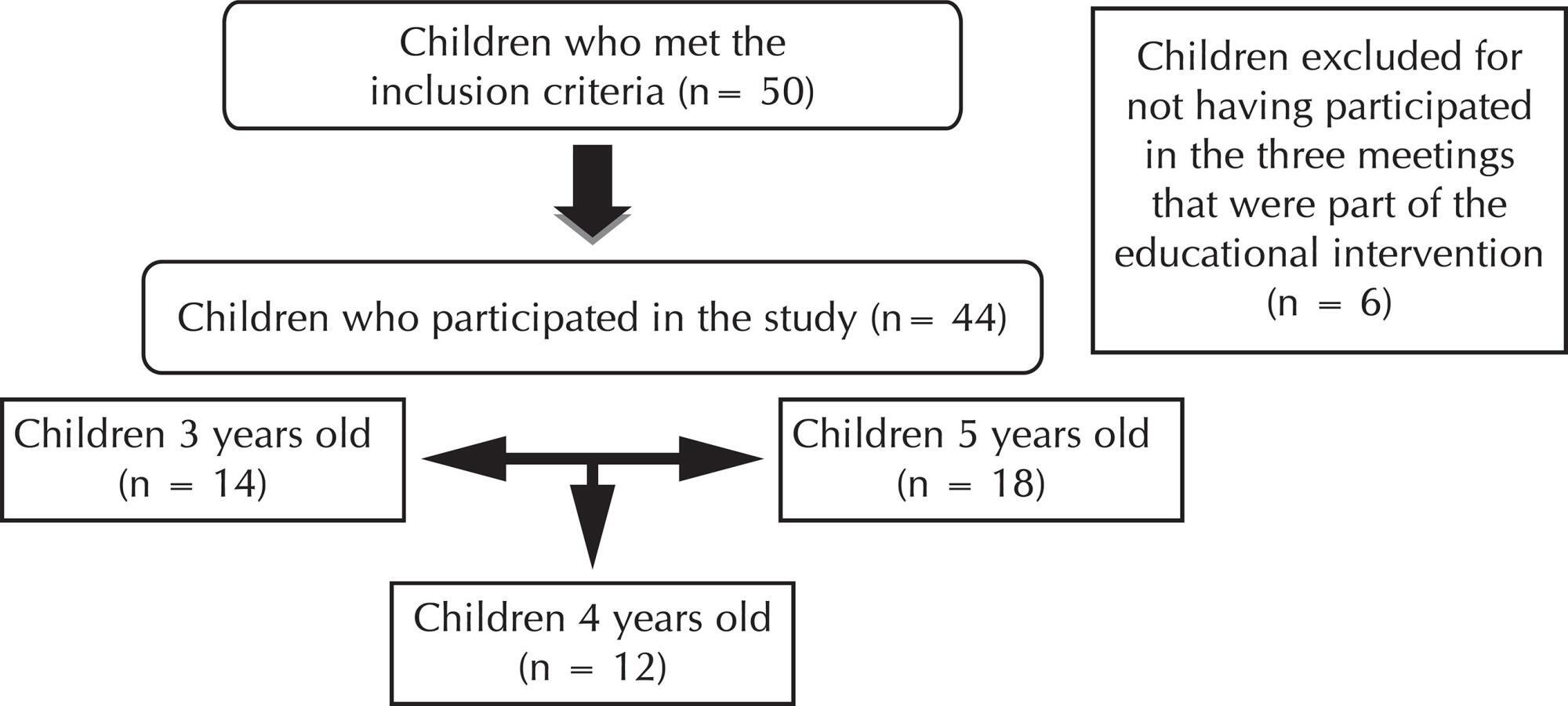
-
PESQUISA01/01/2017
Violence against children and adolescents: the perspective of Primary Health Care
Revista Brasileira de Enfermagem. 2017;70(3):511-518
Resumen
PESQUISAViolence against children and adolescents: the perspective of Primary Health Care
Revista Brasileira de Enfermagem. 2017;70(3):511-518
DOI 10.1590/0034-7167-2016-0471
Visualizações0Ver maisABSTRACT
Objective:
To analyze the care provided by Basic Health Units (BHU) to families involved in domestic intrafamily violence against children and adolescents.
Method:
Qualitative research, based on the Paradigm of Complexity. Data collection was performed with 41 professionals through focus groups and semi-structured interviews.
Results:
The following categories emerged from data analysis: ‘Everything comes here’, which reflects the legitimate place of BHUs for the population and the actions taken to build care for families; and ‘We only do what is really necessary’, which brings the look to violence still based on the positivist and biomedical paradigm.
Final considerations:
The model of understanding and construction of work processes in the BHU is structured in the aforementioned paradigm. Nurses have the possibility to become agents of change, both in professionals’ training and in the care thought and provided to communities.
-
PESQUISA01/01/2017
Integrality of care: challenges for the nurse practice
Revista Brasileira de Enfermagem. 2017;70(3):504-510
Resumen
PESQUISAIntegrality of care: challenges for the nurse practice
Revista Brasileira de Enfermagem. 2017;70(3):504-510
DOI 10.1590/0034-7167-2016-0380
Visualizações0Ver maisABSTRACT
Objective:
to understand the role of the nurse in the collegiate management model of a teaching hospital, in the integrality of care perspective.
Method:
a single case study with multiple units of analysis, with the theoretical proposition «integrality of care is a result of the care offered to the user by multiple professionals, including the nurse». Data were obtained in a functional unit of a teaching hospital through interviews with 13 nurses in a non-participant observation and document analysis.
Results:
from the analytical categories emerged subcategories that allowed understanding that the nurse promotes integrality of care through nursing management, team work and integration of services.
Final considerations:
the theoretical proposition was confirmed and it was verified that the nursing management focus on attending to health care needs and is a strategy to provide integrality of care.
-
PESQUISA01/01/2017
Low completion rate of hepatitis B vaccination in female sex workers
Revista Brasileira de Enfermagem. 2017;70(3):489-494
Resumen
PESQUISALow completion rate of hepatitis B vaccination in female sex workers
Revista Brasileira de Enfermagem. 2017;70(3):489-494
DOI 10.1590/0034-7167-2016-0567
Visualizações0Ver maisABSTRACT
Objective:
to assess predictive factors for noncompletion of the hepatitis B vaccination schedule in female sex workers in the city of Teresina, Northeastern Brazil.
Method:
402 women were interviewed and, for those who did not wish to visit specialized sites, or did not know their hepatitis B vaccination status, the vaccine was offered at their workplaces. Bi- and multivariate analyses were performed to identify potential predictors for noncompletion of the vaccination schedule.
Results:
of the 284 women eligible for vaccination, 258 (90.8%) received the second dose, 157/258 (60.8%) and 68/258 (26.3%) received the second and third doses, respectively. Working at clubs and consuming illicit drugs were predictors for noncompletion of the vaccination schedule.
Conclusion:
the high acceptability of the vaccine’s first dose, associated with low completion rates of the vaccination schedule in sex workers, shows the need for more persuasive strategies that go beyond offering the vaccine at their workplaces.
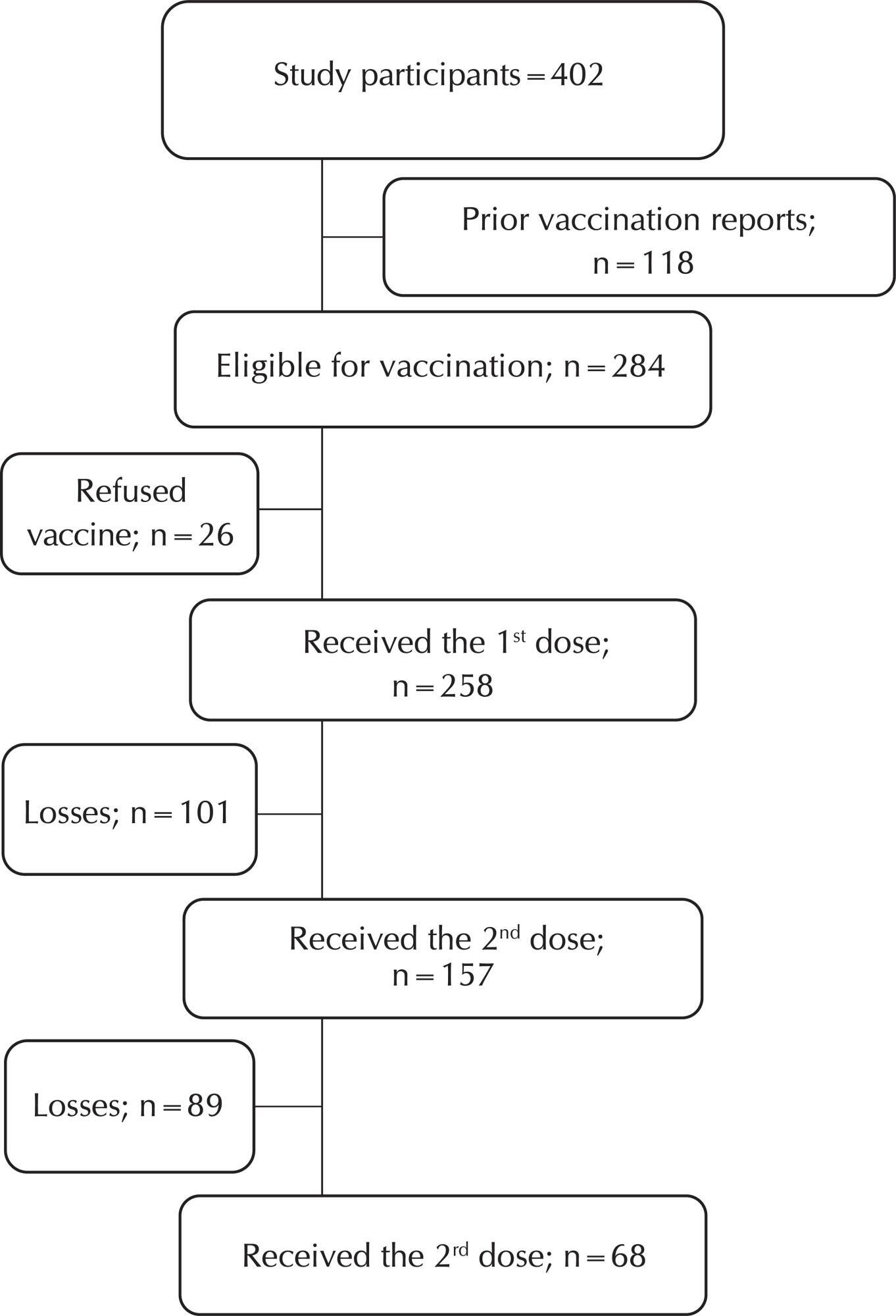
-
PESQUISA01/01/2017
Cost of nursing most frequent procedures performed on severely burned patients
Revista Brasileira de Enfermagem. 2017;70(3):481-488
Resumen
PESQUISACost of nursing most frequent procedures performed on severely burned patients
Revista Brasileira de Enfermagem. 2017;70(3):481-488
DOI 10.1590/0034-7167-2015-0034
Visualizações0Ver maisABSTRACT
Objective:
to identify the mean direct cost (MDC) of the most frequent procedures performed by nursing professionals on severely burned patients in an Intensive Care Unit.
Method:
exploratory-descriptive quantitative single-case study. The MDC was calculated by multiplying time (timed) spent by nursing professionals in the performance of the procedures by the unit cost of direct labor, and adding the costs of material and medicine/solutions.
Results:
a MDC of US$ 0.65 (SD=0.36) was obtained for «vital signs monitoring»; US$ 10.00 (SD=24.23) for «intravenous drug administration»; US$ 5.90 (SD=2.75) for «measurement of diuresis»; US$ 0.93 (SD=0.42) for «capillary blood glucose monitoring»; and US$ 99.75 (SD=129.55) for «bandaging».
Conclusion:
the knowledge developed can support managerial decision-making, contribute to the efficiency distribution of the resources involved and, when possible, provide cost-containment or cost-minimization strategies without impairing the quality of nursing care.
-
PESQUISA01/01/2017
Nursing Activities Score and Acute Kidney Injury
Revista Brasileira de Enfermagem. 2017;70(3):475-480
Resumen
PESQUISANursing Activities Score and Acute Kidney Injury
Revista Brasileira de Enfermagem. 2017;70(3):475-480
DOI 10.1590/0034-7167-2016-0266
Visualizações0Ver maisABSTRACT
Objective:
to evaluate the nursing workload in intensive care patients with acute kidney injury (AKI).
Method:
A quantitative study, conducted in an intensive care unit, from April to August of 2015. The Nursing Activities Score (NAS) and Kidney Disease Improving Global Outcomes (KDIGO) were used to measure nursing workload and to classify the stage of AKI, respectively.
Results:
A total of 190 patients were included. Patients who developed AKI (44.2%) had higher NAS when compared to those without AKI (43.7% vs 40.7%), p <0.001. Patients with stage 1, 2 and 3 AKI showed higher NAS than those without AKI. A relationship was identified between stage 2 and 3 with those without AKI (p = 0.002 and p <0.001).
Conclusion:
The NAS was associated with the presence of AKI, the score increased with the progression of the stages, and it was associated with AKI, stage 2 and 3.
-
PESQUISA01/01/2017
Nursing appointment and cardiometabolic control of diabetics: a randomized clinical trial
Revista Brasileira de Enfermagem. 2017;70(3):468-474
Resumen
PESQUISANursing appointment and cardiometabolic control of diabetics: a randomized clinical trial
Revista Brasileira de Enfermagem. 2017;70(3):468-474
DOI 10.1590/0034-7167-2016-0352
Visualizações0Ver maisABSTRACT
Objective:
to verify the effect of nursing appointment on cardiometabolic profile of people with Diabetes Mellitus type 2.
Method:
randomized controlled trial, developed with 134 individuals chosen for two groups: intervention and control. The intervention consisted of three nursing appointments alternated bimonthly, with two phone calls, over five months. The control group received usual care offered by the Health Unit. Data were collected through semi-structured interviews before and after the intervention, in addition to conducting laboratory tests.
Results:
after the intervention, a significant difference was shown in the amount of glycated hemoglobin (p = 0.006) and in the systolic blood pressure (p = 0.031), which were higher in the control group.
Conclusion:
besides being low-cost and easy to develop on the monitoring routine of people with diabetes, the intervention performed influenced positively the biochemical profile.
-
PESQUISA01/01/2017
Terms of the specialized nursing language for the care of ostomates
Revista Brasileira de Enfermagem. 2017;70(3):461-467
Resumen
PESQUISATerms of the specialized nursing language for the care of ostomates
Revista Brasileira de Enfermagem. 2017;70(3):461-467
DOI 10.1590/0034-7167-2015-0058
Visualizações0Ver maisABSTRACT
Objectives:
to identify terms of the specialized nursing language for the care of ostomates from the literature of the area, and to map the identified terms with terms of the International Classification for Nursing Practice (ICNP®).
Method:
descriptive study of quantitative approach guided by the guidelines for the elaboration of terminology subsets of the ICNP®. The terms were collected in 49 scientific articles, extracted using a computational tool, selected according to the relevance for the theme, and normalized and mapped with the ICNP®.
Results:
20,668 terms were extracted. The standardization process resulted in 425 relevant terms (151 were constant in ICNP® and 274 were not contained in ICNP®), of which 154 were similar, 19 were more comprehensive, 50 were more restricted, and 51 were not in concordance.
Conclusion:
the use of standardized language can minimize the ambiguities and redundancies identified in the mapping. The existence of terms not in concordance with the ICNP® reinforces the need for constant updating of this classification.
-
ARTÍCULO ORIGINAL08/07/2020
Nurses’ practice in quilombola communities: an interface between cultural and political competence
Revista Brasileira de Enfermagem. 2020;73(5):e20190433
Resumen
ARTÍCULO ORIGINALNurses’ practice in quilombola communities: an interface between cultural and political competence
Revista Brasileira de Enfermagem. 2020;73(5):e20190433
DOI 10.1590/0034-7167-2019-0433
Visualizações1Ver maisABSTRACT
Objectives:
to understand Family Health Strategy nurses’ practices in the context of quilombola communities with an interface for cultural and political competences.
Methods:
a single integrated, qualitative case study carried out on seven Family Health Strategies located in the Metropolitan Region of Belo Horizonte, state of Minas Gerais. Seven nurses and 59 quilombolas participated. Data were collected through individual interviews with nurses, collective interviews with quilombolas and observation. For analysis, the thematic content analysis was adopted.
Results:
the results revealed structural and territorial problems, which are configured as barriers for professional-user encounter as well as for professional practice performance.
Final Considerations:
it is necessary that Family Health Strategy nurses, based on political and cultural competences, create strategies that minimize the difficulties found in the implementation of health actions directed to quilombolas. Such strategies anchored in inclusive public policies.
-
ARTÍCULO ORIGINAL08/07/2020
No to distance education! Production of meaning of discourses of nursing representative entities
Revista Brasileira de Enfermagem. 2020;73(5):e20190465
Resumen
ARTÍCULO ORIGINALNo to distance education! Production of meaning of discourses of nursing representative entities
Revista Brasileira de Enfermagem. 2020;73(5):e20190465
DOI 10.1590/0034-7167-2019-0465
Visualizações0Ver maisABSTRACT
Objectives:
to analyze the processes of production of meanings, based on the positions of Brazilian nursing representative entities, on distance education, considering the implications for nursing as a discipline, profession and work.
Methods:
this documentary research was carried out in sources from the Federal Nursing Council and Associação Brasileira de Enfermagem, from 2015 to 2018. Data were examined from discourse analysis, using paraphrase and polysemy as analytical devices.
Results:
they were organized based on the effects of meanings produced and affiliated to two analytical categories: “Forms of mobilization and operating entities” and “Basis and justifications for the positions”.
Final Considerations:
the discourses signal concern about the future training of new professionals. Resistance, participation, visibility, broad and emphatic debate on the topic are shown as strategies for coping and defending a training process less captured by neoliberal logic, and more relational and committed to the quality of health care.
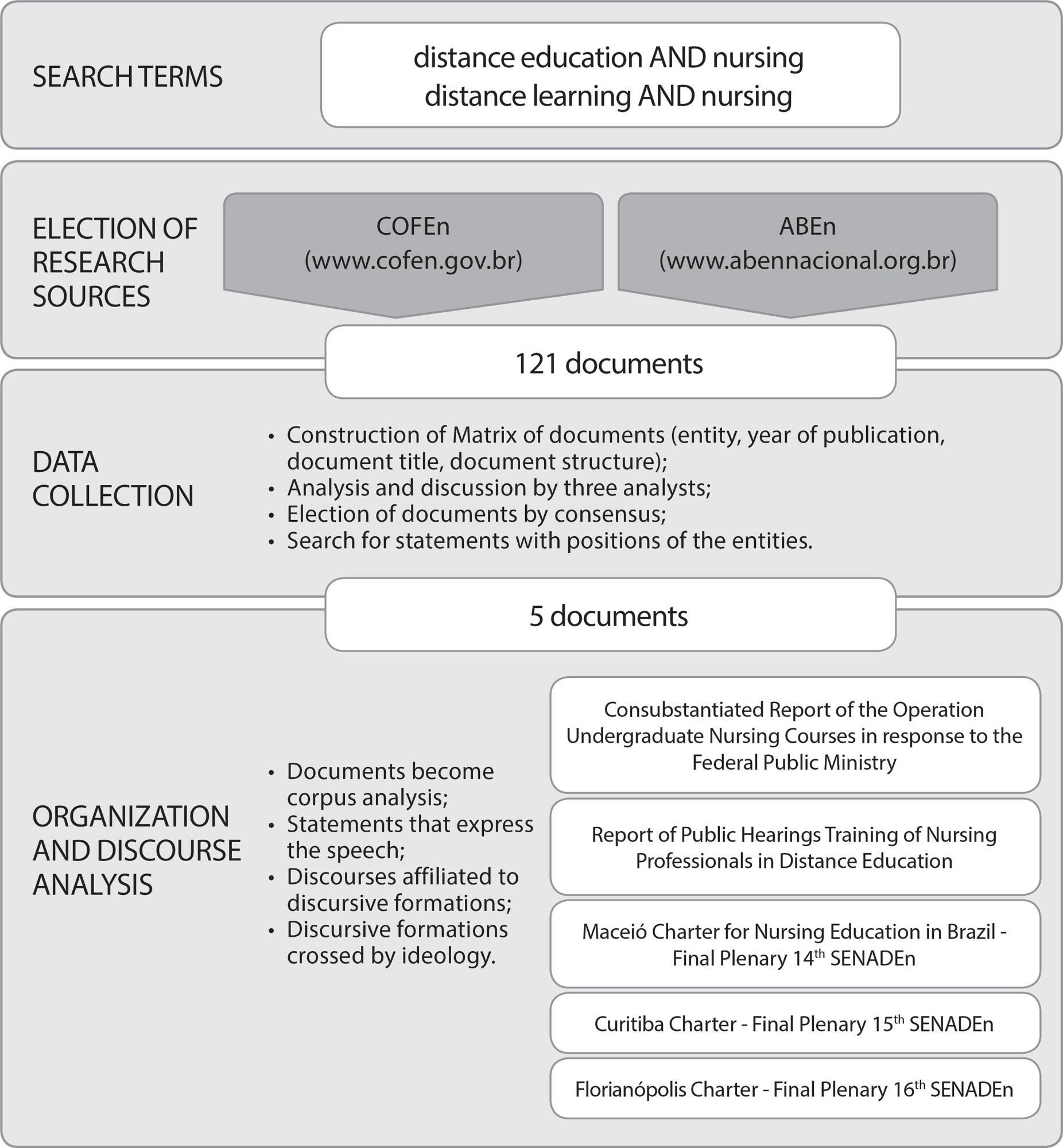
-
ARTÍCULO ORIGINAL13/07/2020
Culture of patient safety in hospital units of gynecology and obstetrics: a cross-sectional study
Revista Brasileira de Enfermagem. 2020;73(5):e20190576
Resumen
ARTÍCULO ORIGINALCulture of patient safety in hospital units of gynecology and obstetrics: a cross-sectional study
Revista Brasileira de Enfermagem. 2020;73(5):e20190576
DOI 10.1590/0034-7167-2019-0576
Visualizações0Ver maisABSTRACT
Objectives:
to assess the patient safety culture of the health team working in three maternity hospitals.
Methods:
observational, cross-sectional, comparative study. 301 professionals participated in the study. The Hospital Survey on Patient Safety Culture questionnaire validated in Brazil was used. For data analysis, it was considered a strong area in the patient safety culture when positive responses reached over 75%; and areas that need improvement when positive responses have reached less than 50%. To compare the results, standard deviation and thumb rule were used.
Results:
of the 12 dimensions of patient safety culture, none obtained a score above 75%, with nine dimensions scoring between 19% and 43% and three dimensions between 55% and 57%.
Conclusions:
no strong dimensions for safety culture were identified in the three maternity hospitals. It is believed that these results may contribute to the development of policies that promote a culture of safety in institutions.
-
ARTÍCULO DE REVISIÓN13/07/2020
The quality of life of family health professionals: a systematic review and meta-synthesis
Revista Brasileira de Enfermagem. 2020;73(5):e20190645
Resumen
ARTÍCULO DE REVISIÓNThe quality of life of family health professionals: a systematic review and meta-synthesis
Revista Brasileira de Enfermagem. 2020;73(5):e20190645
DOI 10.1590/0034-7167-2019-0645
Visualizações1Ver maisABSTRACT
Objectives:
to perform a systematic review and meta-synthesis of qualitative studies about the work-related quality of life of Family Health Strategy professionals.
Methods:
this systematic review was developed to answer the following PVO question: “Which factors (variables) are associated with the work-related quality of life (outcome) of Family Health Strategy professionals (population)?” The PubMed, Scopus, Embase, SciELO, Web of Science, LILACS, Science Direct, OpenThesis, OpenGrey, and OATD databases were selected. The meta-synthesis analyzed the main codes and secondary codes of all included studies.
Results:
the database search resulted in 1,744 reports; six were considered eligible for the meta-synthesis. Four factors were considered for the quality of work life: working conditions; work processes; interpersonal relationships; and personal aspects.
Conclusions:
although this study confirms the adequacy of aspects commonly related to the quality of work life, other factors are important in the case of FHS professionals, especially work context.
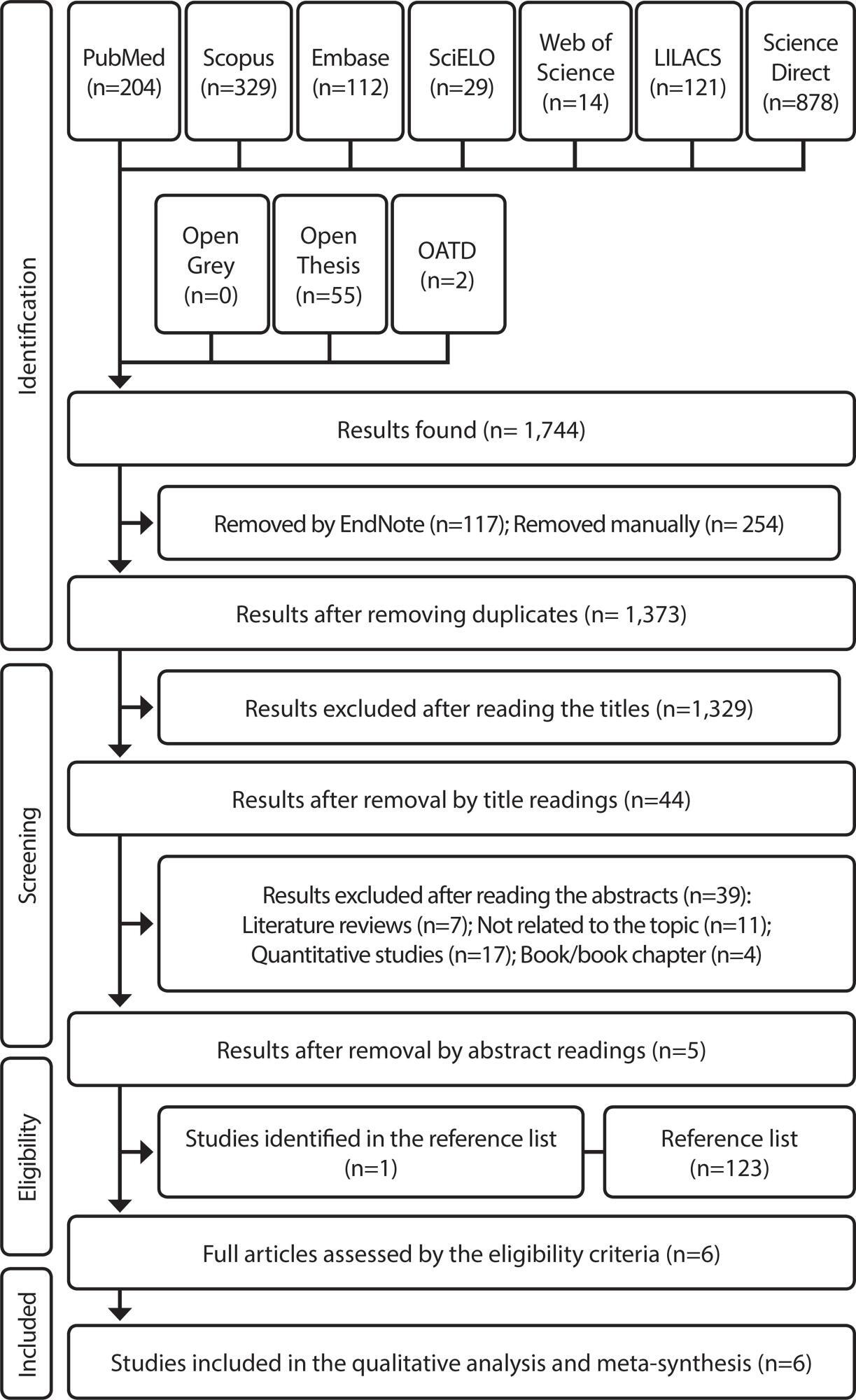
-
CARTA AL EDITOR01/07/2020
Letter to the Editor: doubts and considerations about Coronary Syndrome
Revista Brasileira de Enfermagem. 2020;73(5):e2020730502c
Resumen
CARTA AL EDITORLetter to the Editor: doubts and considerations about Coronary Syndrome
Revista Brasileira de Enfermagem. 2020;73(5):e2020730502c
DOI 10.1590/0034-7167.2020730502c
Visualizações0Dear Editor,We wrote this letter referring to the article “Impact of anxiety and depression on morbidity and mortality of patients with coronary syndrome”() to make some comments, in order to clarify doubts that we were missing from answering. We have already made it clear that our intention is not to question the work of the […]Ver mais -
ARTÍCULO ORIGINAL10/08/2020
Workers’ Health in Brazil: Accidents recorded by Social Security from 2008 to 2014
Revista Brasileira de Enfermagem. 2020;73(6):e20180892
Resumen
ARTÍCULO ORIGINALWorkers’ Health in Brazil: Accidents recorded by Social Security from 2008 to 2014
Revista Brasileira de Enfermagem. 2020;73(6):e20180892
DOI 10.1590/0034-7167-2018-0892
Visualizações0Ver maisABSTRACT
Objectives:
to analyze the incidence of occupational accidents in Brazil, recorded by Social Security according to the geographic regions, age group, gender and their prevalence according to the causes and branch of economic activity.
Methods:
ecological descriptive study with time series analysis from 2008 to 2014. Data on the beginning and end of the historical series were compared in each ecological unit studied.
Results:
the South and Southeast regions, male, between 20 and 49 years of age presented the highest falls in incidence. 70.87% of the causes occurred in group XIX of ICD-10. The economic activity with the highest prevalence of accidents was the manufacturing industry.
Conclusions:
accidents at work have decreased in Brazil, however, the incidence is still high. Advances need to be made in the recording of accidents and in the prevention and surveillance of workers’ health.
-
ARTÍCULO ORIGINAL10/08/2020
Neonatal near miss in the intensive care unit
Revista Brasileira de Enfermagem. 2020;73(6):e20180931
Resumen
ARTÍCULO ORIGINALNeonatal near miss in the intensive care unit
Revista Brasileira de Enfermagem. 2020;73(6):e20180931
DOI 10.1590/0034-7167-2018-0931
Visualizações0Ver maisABSTRACT
Objective:
To analyze near miss cases among newborns hospitalized in the Intensive Care Unit.
Methods:
An observational, cross-sectional, retrospective study using the STROBE guideline. Data were collected from 1,101 records of live births (newborns). Statistical analysis used the Epi-Info program 3.3.2 and Chi-square and Fisher’s exact tests.
Results:
A total of 162 newborns were hospitalized, of which 63 had at least one criterion of near miss. The variables that remained associated with neonatal near miss were weight <1.750 g, gestational age <33 weeks and Apgar at 5 minutes <7, pragmatic criteria to identify cases of neonatal near miss morbidity.
Conclusion:
Prematurity and low birth weight were the factors that contributed most to the near miss outcome among newborns hospitalized in intensive care, a rate two and a half times higher than the number of deaths, according to scientific evidence.

-
10/08/2020
Care for the critical patient undergoing point-of-care testing: integrative review
Revista Brasileira de Enfermagem. 2020;73(6):e20180948
Resumen
Care for the critical patient undergoing point-of-care testing: integrative review
Revista Brasileira de Enfermagem. 2020;73(6):e20180948
DOI 10.1590/0034-7167-2018-0948
Visualizações0Ver maisABSTRACT
Objective:
to identify, based on the evidence, point-of-care testing in bedbound in critically ill patients.
Method:
integrative review, carried out through search in Pubmed, Virtual Health Library, Joanna Briggs Institute, The British Institute of Radiology, Brazilian Radiology, and Google Scholar databases. We used the PICO research strategy and selected articles published from 2013 onwards, which presented information about point-of-care testing.
Results:
the different interventions found in the analysis of the 23 selected articles allowed the thematic grouping of care related to safety in communication, patient identification, care with devices, and the prevention and control of infection, which can be used in point-of-care testing.
Final considerations:
The care described in the evidence provided support for validating a safe care protocol for critically ill patients undergoing imaging studies in bed.
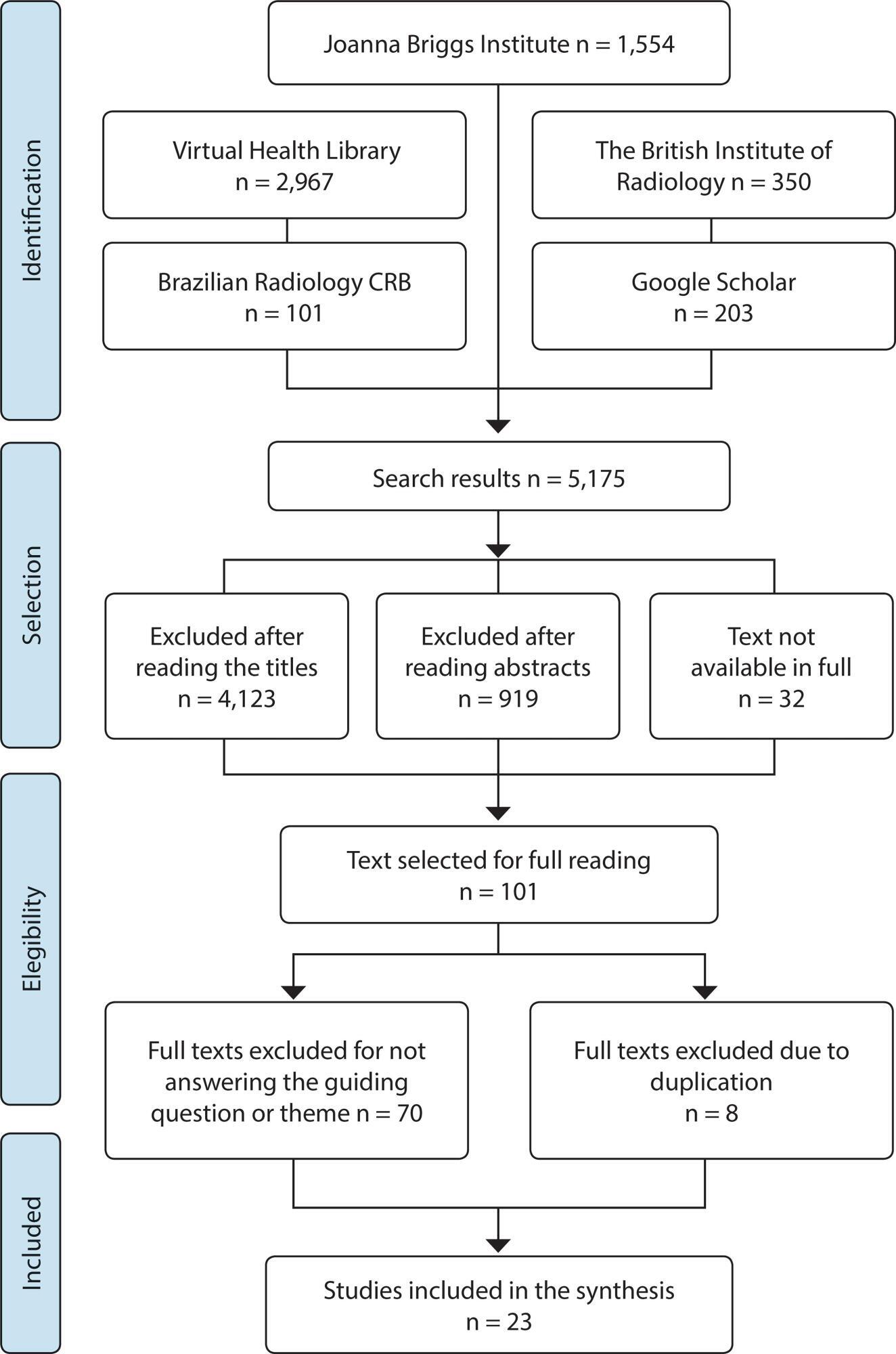
-
ARTÍCULO ORIGINAL24/06/2020
Interprofessional relationships of a patient assistance team in critical care
Revista Brasileira de Enfermagem. 2020;73(4):e20190420
Resumen
ARTÍCULO ORIGINALInterprofessional relationships of a patient assistance team in critical care
Revista Brasileira de Enfermagem. 2020;73(4):e20190420
DOI 10.1590/0034-7167-2019-0420
Visualizações0Ver maisABSTRACT
Objectives:
to identify perceptions of teamwork according to the professionals of an Adult Intensive Care Unit.
Methods:
descriptive research with qualitative approach. The methodological framework was thematic content analysis. The theoretical framework of the work process was used to guide the interpretation of the data. Data collection: A semi-structured interview was conducted with 38 professionals in a public teaching hospital in the state of Minas Gerais. Results: three thematic categories emerged from the interviews: Work Organization, which is related to work performed through tasks/routines, with or without coordinated actions; Non-material Work Instruments, which reveal that teamwork is based on communication/collaboration; Insufficient Material Resources, which indicate that lack of material creates conflicts between professionals.
Conclusions:
Teamwork requires effective communication and collaboration, integrated work and appropriate professional training. On the other hand, fragmentation and rigidity at work, poor collaboration/communication and lack of material make teamwork difficult. We emphasize the need to revise the curriculum of health courses, with a view to including and/or improving discussions about teamwork in order to train professionals for a more integrated and perhaps even sympathetic health practice.
-
ARTÍCULO ORIGINAL01/07/2020
Conhecimento de profissionais da atenção primária em saúde sobre política de saúde para populações ribeirinhas
Revista Brasileira de Enfermagem. 2020;73(5):e20190080
Resumen
ARTÍCULO ORIGINALConhecimento de profissionais da atenção primária em saúde sobre política de saúde para populações ribeirinhas
Revista Brasileira de Enfermagem. 2020;73(5):e20190080
DOI 10.1590/0034-7167-2019-0080
Visualizações0RESUMO
Objetivos:
analisar conhecimentos dos profissionais de saúde sobre a política de saúde para a população ribeirinha; analisar o desenvolvimento das práticas de saúde direcionadas a esse grupo e discutir facilidades e dificuldades de implementar essa política.
Métodos:
estudo qualitativo, descritivo, com 24 profissionais das Equipes de Estratégia Saúde da Família Ribeirinha no município de Belém-Pará. Os dados foram produzidos em entrevista individual e analisados por Análise de Conteúdo.
Resultados:
embora os profissionais conheçam algo da política pública de saúde, há necessidade de ampliar e fortalecer conhecimentos sobre a política de saúde para população ribeirinha. As atividades direcionadas às comunidades ocorriam na própria Unidade, sendo que algumas não eram desenvolvidas por insuficiência de recursos materiais e humanos.
Considerações Finais:
a maior dificuldade para a organização da assistência à saúde é a carência de recursos materiais e humanos, e a maior facilidade é a união e coesão na equipe de saúde.
Palavras-chave: Assistência à SaúdeAtenção Primária em SaúdeEstratégia Saúde da FamíliaPolítica de SaúdePopulações VulneráveisVer mais -
ARTÍCULO ORIGINAL19/08/2019
The daily routine of nurses in rural areas in the Family Health Strategy
Revista Brasileira de Enfermagem. 2019;72(4):918-925
Resumen
ARTÍCULO ORIGINALThe daily routine of nurses in rural areas in the Family Health Strategy
Revista Brasileira de Enfermagem. 2019;72(4):918-925
DOI 10.1590/0034-7167-2018-0243
Visualizações0Ver maisABSTRACT
Objective:
to analyze the daily work of rural Family Health Strategy (FHS) nurses.
Method:
a qualitative, descriptive and exploratory research. The data were collected with eleven rural nurses of the city of Campina Grande, Paraíba State, through semi-structured interviews, between January and March of 2017, using Content Analysis.
Results:
rural nurses have a strong relationship with the population. However, they reveal a daily work with various organizational barriers that range from the team displacement to the workplace to the operationalization of health actions, which are mediated by the characteristics of rurality. Some of these barriers can be remedied by a more proactive action from the management.
Final considerations:
conditioned by the characteristics of rurality, the differentiated dynamics work reveal weaknesses in the quality of nursing care and lower effectiveness of the FHS.
-
ARTÍCULO ORIGINAL06/07/2020
Tempo e qualidade das admissões: carga de trabalho em enfermagem
Revista Brasileira de Enfermagem. 2020;73(5):e20190267
Resumen
ARTÍCULO ORIGINALTempo e qualidade das admissões: carga de trabalho em enfermagem
Revista Brasileira de Enfermagem. 2020;73(5):e20190267
DOI 10.1590/0034-7167-2019-0267
Visualizações0RESUMO
Objetivos:
mensurar o tempo médio despendido pela equipe de enfermagem durante a admissão de pacientes e investigar sua conformidade em relação às atividades descritas pela Classificação das Intervenções de Enfermagem; avaliar o grau de interferência sobre a carga de trabalho da equipe.
Métodos:
observacional com cronometragem de tempo por meio de um software. Acompanharam-se 199 admissões realizadas pela equipe de enfermagem em sete unidades utilizando-se dois instrumentos validados. Escores total ≥ 70% e 50% qualificavam o processo.
Resultados:
o tempo médio dos enfermeiros variou de 5,5 (desvio padrão = 2,3) a 13 (desvio padrão = 1,1) minutos; e dos auxiliares/técnicos, entre 4,7 (desvio padrão = 2,1) e 6,8 (desvio padrão = 2,0) minutos (p ≤ 0,01). Seis admissões realizadas por enfermeiros e 33 por auxiliares/técnicos mostraram-se qualificadas. A intervenção despendeu de 16,3% a 31,5% do tempo da jornada de trabalho da equipe.
Conclusões:
a admissão impacta a carga de trabalho e precisa ser considerada tanto na mensuração das atividades como no dimensionamento da equipe de enfermagem.
Palavras-chave: Avaliação de Processos em Cuidados de SaúdeCarga de TrabalhoFluxo de TrabalhoGerenciamento do TempoRecursos Humanos de EnfermagemVer mais -
ARTÍCULO ORIGINAL18/05/2020
Care of wheelchair pregnant women in the light of Collière’s theory
Revista Brasileira de Enfermagem. 2020;73(4):e20180755
Resumen
ARTÍCULO ORIGINALCare of wheelchair pregnant women in the light of Collière’s theory
Revista Brasileira de Enfermagem. 2020;73(4):e20180755
DOI 10.1590/0034-7167-2018-0755
Visualizações0Ver maisABSTRACT
Objectives:
to discuss care needs of wheelchair pregnant women in the light of Collière’s Theory of Caring.
Methods:
qualitative, descriptive, exploratory, with eight women, between August 2014 and March 2015, in Rio de Janeiro State, Brazil. The method of data collection was the life history. The theoretical reference used was Marie-Françoise Collière’s Theory of Caring. The thematic type analysis identified three categories: pregnancy planning; support and prejudice of family and health professionals; and caring for the wheelchair pregnant woman.
Results:
prejudice, fear, lack of support, lack of knowledge about the maintenance of pregnancy and childbirth interfered negatively in the process of gestation. Participants had urinary tract infection, miscarriages and preterm birth.
Final Considerations:
gestation in these women should predict possible intercurrences, which makes it imperative to train professionals in integral care to promote and protect health.
-
ARTÍCULO ORIGINAL09/04/2020
Trabalho e competência do enfermeiro nos serviços de hemoterapia: uma abordagem ergológica
Revista Brasileira de Enfermagem. 2020;73(3):e20180775
Resumen
ARTÍCULO ORIGINALTrabalho e competência do enfermeiro nos serviços de hemoterapia: uma abordagem ergológica
Revista Brasileira de Enfermagem. 2020;73(3):e20180775
DOI 10.1590/0034-7167-2018-0775
Visualizações1RESUMO
Objetivos:
analisar os ingredientes da competência que os enfermeiros utilizam na realização do seu trabalho na hemoterapia.
Métodos:
estudo qualitativo com 22 enfermeiros, realizado por meio de estudo documental, observação e entrevista semiestruturada, com recursos do software Atlas.ti, embasado nos fundamentos do Materialismo Histórico Dialético e da Ergologia. Foi efetuada Análise de Conteúdo.
Resultados:
o domínio do conhecimento específico da hemoterapia e o tempo de experiência na área, aliados à motivação do trabalhador e à capacidade de trabalho em equipe, favorecem o agir com competência nas atividades laborais. Por outro lado, a falta de condições adequadas de trabalho, especialmente em relação a materiais, equipamentos e estrutura adequados, prejudica o trabalho do enfermeiro em hemoterapia.
Considerações Finais:
a experiência adquirida é determinante para o sucesso na tomada de decisão. Além disso, condições adequadas de trabalho, atualização de conhecimentos e habilidade no trabalho em equipe favorecem um cenário de práticas seguras.
Palavras-chave: Assistência de EnfermagemDoação de SangueServiço de HemoterapiaTrabalhoTransfusão de SangueVer mais -
ARTÍCULO ORIGINAL25/10/2022
Caracterização clínica, incapacidade e mortalidade de pessoas com acidente vascular cerebral isquêmico em 90 dias
Revista Brasileira de Enfermagem. 2022;75(2):e20201383
Resumen
ARTÍCULO ORIGINALCaracterização clínica, incapacidade e mortalidade de pessoas com acidente vascular cerebral isquêmico em 90 dias
Revista Brasileira de Enfermagem. 2022;75(2):e20201383
DOI 10.1590/0034-7167-2020-1383
Visualizações0RESUMO
Objetivos:
descrever características clínicas e a mortalidade de pessoas com acidente vascular cerebral isquêmico; comparar a incapacidade antes do evento e 90 dias depois.
Métodos:
estudolongitudinal, com 308 pessoas hospitalizadas em Salvador-BA. A coleta de dados ocorreu de 03/2019 a 01/2020. Empregou-se estatística descritiva e inferencial.
Resultados:
a média de idade foi de 64,8 anos ( dp=14,1) e a pontuação da National Institute of Health Stroke Scale foi 10,7 (dp=7,2). Amediana do tempo de internação foi de 11 dias. Predominaram negros (84,0%), escolaridade até o fundamental (68,4%), renda até três salários mínimos (89,1%), chegada até 4,5 horas do início dos sintomas (57,9%) e internação em unidade especializada (71,8%). Realizaram trombólise: 26,0%. Predominou a categoria assintomática (85,3%) antes do evento e incapacidade moderada/severa (41,5%) após 90 dias (p= 0.117). Óbito atingiu 19,7% da amostra.
Conclusões:
a alta mortalidade e incapacidade geradas pelo evento têm implicações para a gestão e cuidado em saúde.
Palavras-chave: Acidente Vascular CerebralEnfermagemEpidemiologiaEstatísticas de Sequelas e IncapacidadePrevenção de DoençasVer mais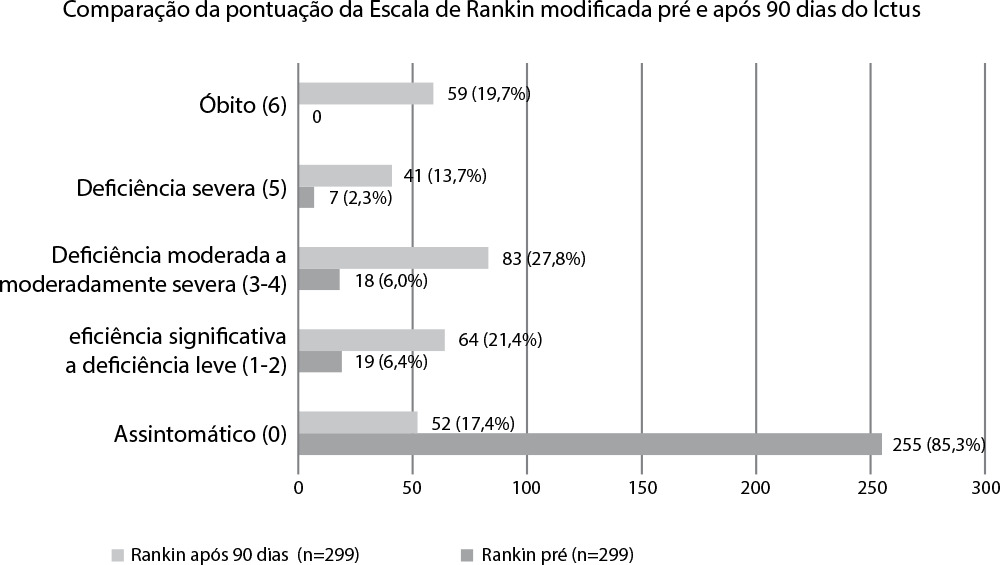
-
ARTÍCULO DE REVISIÓN13/07/2020
Augmentative and Alternative Communication in Ventilated Patients: A Scoping Review
Revista Brasileira de Enfermagem. 2020;73(5):e20190562
Resumen
ARTÍCULO DE REVISIÓNAugmentative and Alternative Communication in Ventilated Patients: A Scoping Review
Revista Brasileira de Enfermagem. 2020;73(5):e20190562
DOI 10.1590/0034-7167-2019-0562
Visualizações0Ver maisABSTRACT
Objectives:
to map the benefits of Augmentative and Alternative Communication in ventilated adults in Intensive Care Unit and identify strategies used.
Methods:
a Scoping Review was carried out according to the Joanna Brigs Institute Protocol. The research question was: “In adult patients ventilated in Intensive Care Units, what are the benefits of Augmentative and Alternative Communication?”. An article research was carried out at PubMed, EBSCOhost and B-On databases. It was held between October and November 2018, from 2013 to 2018, in Portuguese and in English.
Results:
61 references were obtained. After selection according to the inclusion criteria, 7 articles were analyzed.
Conclusions:
studies enunciate Augmentative and Alternative Communication as a strategy to enhance communication, describing methods and tools. There is no agreement on the most effective tool.
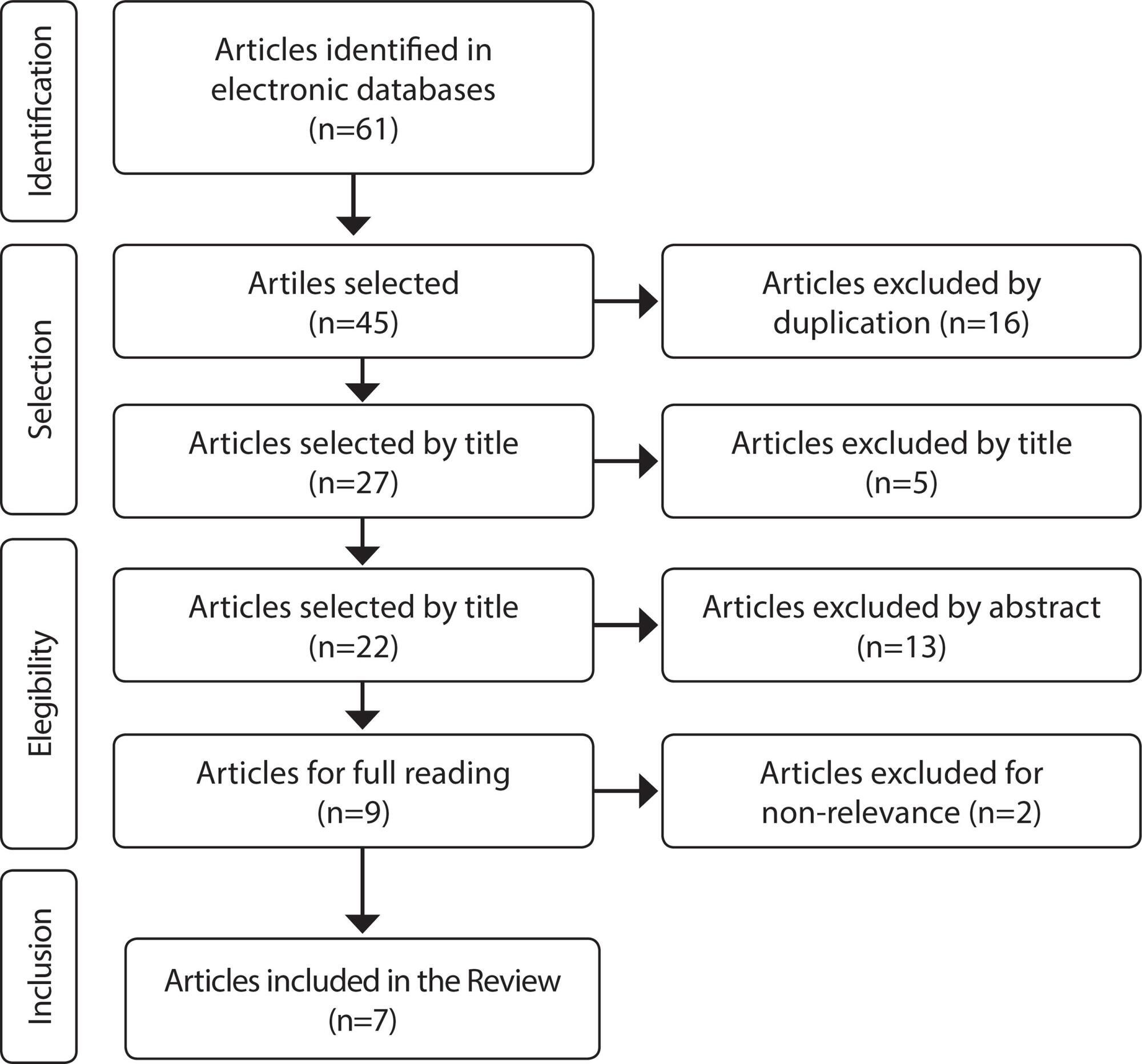
Búsqueda
Buscar en:
Nuvem de Tags
Adolescente (85) Atenção Primária à Saúde (239) COVID-19 (91) Criança (91) Cuidados de Enfermagem (269) Educação em Enfermagem (151) Educação em Saúde (139) Enfermagem (930) Enfermagem Pediátrica (86) Estudantes de Enfermagem (77) Estudos de Validação (131) Família (87) Idoso (208) Promoção da Saúde (99) Qualidade de Vida (104) Saúde do Trabalhador (86) Saúde Mental (145) Saúde Pública (82) Segurança do Paciente (150) Tecnologia Educacional (100)



